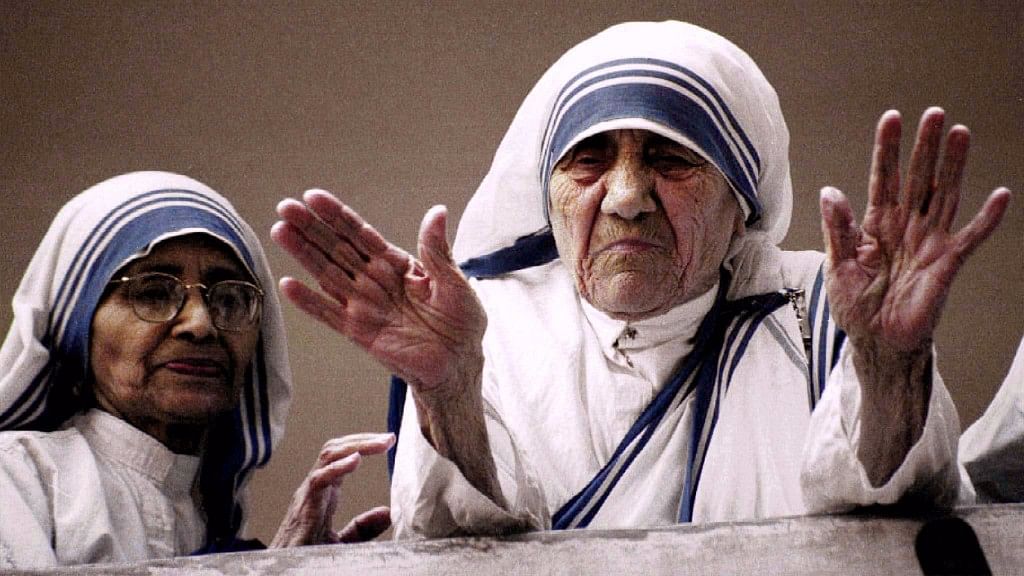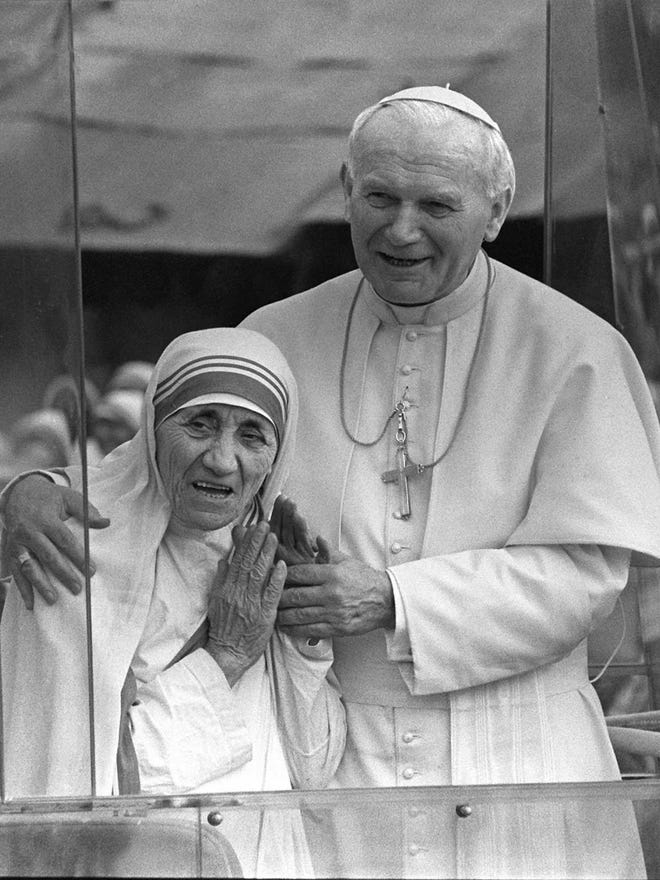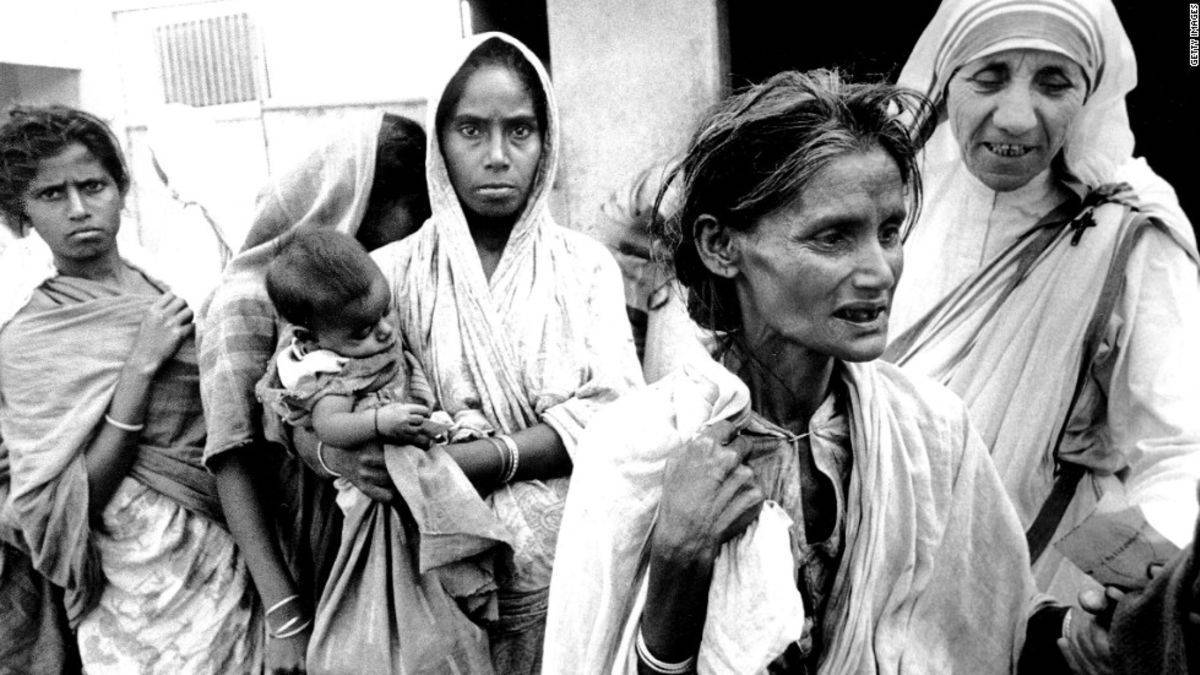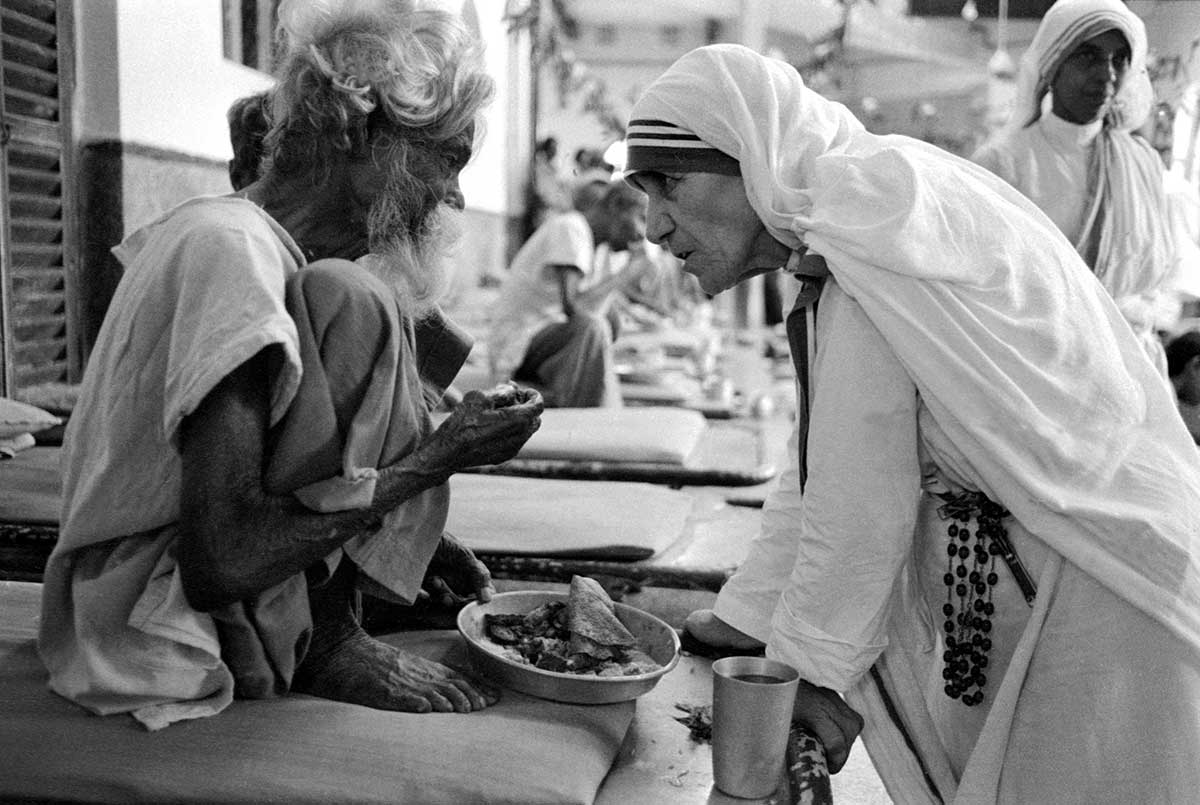MORE COVERAGE
Twitter Coverage
Satyaagrah
Written on
Satyaagrah
Written on
Satyaagrah
Written on
Satyaagrah
Written on
Satyaagrah
Written on
JOIN SATYAAGRAH SOCIAL MEDIA
Saint or Sadist: Reality check of saint of the gutters Mother Teresa

You think Mother Teresa was a saint, right? Perhaps you also believe she lifted millions of poor people around the world out of poverty. Think again.
Teresa was no saint. The Vatican is manufacturing her sainthood because she was at the vanguard of the Roman Catholic Church’s aggressive conversion activities in India. It’s also for favours rendered to the church as Teresa’s rigid stance on abortion and contraception aligned with the views of Pope John Paul II.
During his 26-year papacy, the arch conservative pope elevated 483 individuals to sainthood. That’s more saints than any previous pope. The current pope is, therefore, merely completing the process initiated by the Vatican.
Teresa was no friend of the poor either. On the contrary, the Albanian nun celebrated poverty and suffering, and refused to give medicines to the inmates under her care, in the process allowing them to die painful deaths.
A 2013 study by Canadian researchers backs up what rationalists and neutral observers – like Britain’s Christopher Hitchens – have long held: Teresa only cared about poverty and not the poor. Researchers Serge Larivee and Genevieve Chenard from the University of Montreal and Carole Senechal of the University of Ottawa argue that Teresa was a saint of the media, not the gutters.
 |
The Canadians analysed over 500 published writings about Teresa and conclude that her hallowed image, “which does not stand up to analysis of the facts, was constructed, and that her beatification was orchestrated by an effective media campaign”. Over 50 per cent of the books and articles were hagiographies, they say.
The controversial study, published in the journal of studies in religion and sciences called Religieuses, says Teresa actually felt it was beautiful to see the poor suffer. According to the study, the Vatican overlooked the crucial human side of Teresa – her dubious way of caring for the sick by glorifying their suffering instead of relieving it.
Most people will find this hard to believe all this because the media has painted this lovely picture of a caring mother who dedicated her life to charity. But where she went wrong was in believing suffering was good for the people. She believed in her cause but she had no idea what effect it had on the poor and sick people under her care. A fawning media, obliging politicians and countless donors have overlooked these aspects. But facts are humbling so let’s look at Teresa’s history – the uncensored bits, that is.
Snapshot
|
Tainted Donations
Remember Charles Keating? An investment fraud artist, he was the chairman of the Lincoln Savings and Loan Association, which was the target of a federal investigation after the 1989 savings and loans collapse, which wiped out $160 billion in savings. Many of those affected were ordinary Americans, mostly retirees.
Keating, it was discovered, had given at least $1 million to Teresa and flew her around in his jet. According to The Economist, “Teresa in return praised his good character.” During his trial for fraud, Teresa wrote to the judge, telling him what a good guy Keating was and asked for leniency in sentencing. She advised him to do what Jesus would do.
What Jesus would have done is debatable, but the judge gave Keating 10 years for fraud.
The scene now gets murkier. According to Don Boys, former member of the Indiana House of Representatives, ‘’Teresa received a letter from the Deputy District Attorney telling her that the money Keating had given her was stolen from hard working people and suggested that she return the money. I would have suggested, after all, that is what Jesus would have you do. The good nun never answered his letter (nor returned the stolen money). After all, it was for the ‘poor’.”
During the deliberations over the Second Vatican Council, (Teresa) was to the fore in opposing all suggestions of reform.
Bad Connections
Boys, a conservative Christian, says Teresa or her handlers were very astute in using the media for her own end, raising money for her cause of adding members to the church. ‘’Some of the sugar daddies she fawned over were disreputable, unscrupulous people such as the bloody Haitian dictator Jean-Claude Duvalier (who plundered Haiti), the Communist Albanian dictator Enver Hoxha, Charles Keating, and other scoundrels,” he says.
Taking money from Duvalier, one of the most vicious tyrants to walk the earth, would have been enough to subpoena Teresa. But she didn’t stop there.
 A file photo dated March 1982, shows Haiti ‘s former president Jean-Claude Duvalier (Photo credits-AFP/Getty Images). |
One of the characters in her inner circle was Jim Towey, who became her legal counsel in the late 1980s. In February 2002, President George W. Bush violated both the letter and the spirit of the American constitution by setting up the Office of Faith-Based and Community Initiatives to further the cause of fundamentalist churches and religious conversions worldwide. Towey was appointed director of this office.
Anti-Reformist
Teresa was a faithful servant of the Vatican. In an article on Slate.com, author Christopher Hitchens says, ‘’During the deliberations over the Second Vatican Council, (Teresa) was to the fore in opposing all suggestions of reform. Her position was ultra-reactionary and fundamentalist even in orthodox Catholic terms.” In fact, while receiving the Nobel Peace Prize she told a dumbfounded audience that abortion is “the greatest destroyer of peace.”
(Nobel Prize winning economist and author Steven Levitt has demonstrated in his brilliantly written book, Freakonomics, how the legalisation of abortion contributed to the sharp – and unexpected – drop in crime in the United States. Abortions prevented the birth of unwanted children in families where they would have been disproportionately likely to grow up as criminals.)
 Before sainthood, Pope John Paul II and Mother Teresa in 1986. Copyright 1997 Des Moines Register; No-desm |
Insider Reveals
One of the most compelling accounts of the macabre world of Teresa’s order, the Missionaries of Charity, is by the Australian, Collete Livermore. A nun who worked in Teresa’s order for 11 years, she ended up sick and disillusioned. In 1984 she quit and wrote the book Hope Endures, where she talks about a little known but disturbing side of Teresa, which she says hurt the truly needy.
Livermore explains how the nuns were not provided with medical advice, the use of mosquito repellents, or information about malaria and vaccinations because Teresa believed “God” would look after the nuns. Livermore got into trouble with the order for helping a man with dysentery who was in danger of dying.
“The order cared more about obedience than doing the right thing,” she writes. Teresa quoted the Bible (Peter 2:18-23) which orders slaves to obey their masters even if they are abusive and difficult, and used this text to urge her nuns to obey superiors without question.
In Manila, Teresa wouldn’t let the nuns have a washing machine, which forced them to wash the underwear of the incontinent with brushes. Livermore felt the order was more concerned about inflicting hardship on the nuns than on helping the sick. More angst was in store for Livermore when she was forbidden to help a sick boy named Alex. That’s when Livermore decided to leave the order because she didn’t like the way she was expected to let the poor suffer.
Pain Is Beautiful
Before she died, Teresa had opened over 600 missions in 123 countries. Some of these missions have been described as “homes for the dying” by visiting doctors. The doctors observed a significant lack of hygiene, even unfit conditions, as well as a shortage of actual care, inadequate food and no painkillers. ‘’There is something beautiful in seeing the poor accept their lot, to suffer it like Christ’s passion. The world gains much from their suffering,’’ was her reply to criticism, cites Hitchens.
It would be pertinent to mention here that each time Teresa herself fell sick she sought the finest medical care. Despite the fact that medical tourists from the West travel to India for treatment, Teresa reckoned India wasn’t good enough for her. She was admitted to California’s Scripps Clinic and Research Foundation.
 Mother Teresa a 'troubled individual' in a 'museum of poverty' |
Canonisation Capers
Shortly after her death in September 1997, the pope nominated Teresa for beatification, the first step towards sainthood. However, by doing this the pope violated a Vatican tradition that allowed a cooling off period of five years to guard against dubious characters.
Writes Hitchens-
As for the ‘miracle’ that had to be attested, what can one say? Surely any respectable Catholic cringes with shame at the obviousness of the fakery. A Bengali woman named Monica Besra claims that a beam of light emerged from a picture of (Teresa), which she happened to have in her home, and relieved her of a cancerous tumour. Her physician, Dr Ranjan Mustafi, says that she didn’t have a cancerous tumor in the first place and that the tubercular cyst she did have was cured by a course of prescription medicine. Was he interviewed by the Vatican’s investigators? No.
But then, dubious characters are part of the Christian pantheon. The most famous of these is Saint Dismas, the thief who supposedly died on the cross alongside Jesus. According to Christian legend, Dismas repented only minutes before his death, gaining him entrance to heaven.
Tia Ghose, a senior writer at LiveScience, writes about the near sainthood of Jacques Fesch, a French playboy, bank robber and murderer -
The dissolute and wicked man had fathered two children and abandoned both, then planned a bank heist when his parents refused to foot the bill for a yacht to sail to Tahiti. He shot and killed a police officer in his escape from the heist, and his complete lack of contrition (and general obnoxiousness) spurred the judge to sentence Fresch to death.
In 1957, the charlatan had a fervent change of heart while in prison awaiting the guillotine-
Even in prison, he spent his first months utterly unapologetic, until he had a powerful conversion experience and began to repent his actions. When he was guillotined, his last words were “Holy Mother Mary, have mercy on me.”
Though Fesch hasn’t been officially canonized, a French Cardinal did recommend the man for sainthood. Another unsavoury character that John Paul II put up for sainthood was Pius IX, who reigned as pontiff from 1846 to 1878, and who referred to Jews as “dogs”.
Shaky Faith
Though she was an arch-conservative member of the Catholic Church, Teresa lacked faith, which should effectively debar her from being canonised as a “Christian” saint. Her diaries, investigated by Catholic authorities in Kolkata, revealed that she had been racked with doubts: “I feel that God does not want me, that God is not God and that he does not really exist.”
People think “my faith, my hope and my love are overflowing and that my intimacy with God and union with his will fill my heart. If only they knew,” she wrote, “Heaven means nothing.”
Il Messeggero, Rome’s popular daily newspaper, commented: “The real Mother Teresa was one who for one year had visions and who for the next 50 had doubts – up until her death.”
 |
Poverty Hugger
What did Teresa and her charity achieve in the last six decades? Not even a dent has been made in the sum total of suffering because of Teresa. Take Kolkata. Virtually nothing has changed there, except that Teresa has given that metropolis a rank bad name.
Today, large expanses of India are entering the First World thanks to rapid industrialisation and high economic growth generated by free enterprise. On the other hand, Kolkata, virtually alone among India’s cities, seems stuck in LDC (least developed country) mode.
While its long association with Marxism, another despicable import, may have something to do with the lack of progress, the presence of the poverty mongers ensures the city finds it impossible to shake off its Third World image.
Teresa’s fundraising sermons have drilled into people’s mind that it is a city of lepers and beggars. As Hitchens said, “On one instance the nuns claimed, untruthfully of course, that (Kolkata) had 450,000 lepers, knowing that the rich have a poor conscience and would promptly despatch their dollars.”
Making of a myth
Despite these disturbing facts, how did Teresa succeed in building an image of holiness and infinite goodness? According to the three Canadian researchers, her meeting in London in 1968 with the BBC’s Malcom Muggeridge, an anti-abortion journalist, was what catapulted her to superstardom.
In 1969, Muggeridge made a eulogistic film about the missionary. During filming, the interiors of Teresa’s mission in Kolkata were too dark, and he thought the scene wouldn’t come out well. But when the film was developed it turned out to be amazingly bright. Muggeridge trumpeted it as the ‘’first photographic miracle’’ when it should have been attributed to the new film stock being marketed by Kodak.
Teresa discovered the power of mass media; she travelled the world and received numerous awards, including the Nobel Peace Prize.
 |
No accountability
Today, around the world Teresa’s charities have attained untouchable status, which helps them fend off any attempts by the authorities to stop their morbid experiments on sick and poor people.
There is also the question of the missing millions. Millions of dollars were transferred to the charity’s many bank accounts, but most of the accounts are secret, says Larivee. ‘’Given the parsimonious management of (Teresa’s) works, one may ask where the millions of dollars for the poorest of the poor have gone?’’ he asks.
According to the researchers, Teresa raised almost $100 million before 1980. A good chunk was used for building houses for the missionaries. Just five percent went to the cause. Let’s hear that again – just five percent of that went to the poor.
The legacy
In India where Teresa did her ‘charity’ work for more than half a century, the former government flagged off a train named Mother Express to commemorate her birth centenary in 2010.
Perhaps it’s just a coincidence that the party, and therefore, the country, was headed by the Italian Catholic Sonia Maino, a.k.a. Sonia Gandhi. Christian NGOs and church groups had a free run during her 10 year proxy rule.
Teresa has been known to be stingy even during national emergencies. During numerous floods in India she offered numerous prayers and medallions of the Virgin Mary but no direct or monetary aid, the Canadian researchers say.
It’s noteworthy that all the abandoned children who are taken in Teresa’s missions are brought up as Christians. These children were never offered a choice in the matter of religion.
Teresa was (and her mission continues to be) actively engaged in proselytising work, which will negatively impact India’s complex society. In effect, by allowing the likes of Teresa to operate in India, the government is giving the green light for the long-term balkanisation of the country.
References:
 Support Us
Support Us
Satyagraha was born from the heart of our land, with an undying aim to unveil the true essence of Bharat. It seeks to illuminate the hidden tales of our valiant freedom fighters and the rich chronicles that haven't yet sung their complete melody in the mainstream.
While platforms like NDTV and 'The Wire' effortlessly garner funds under the banner of safeguarding democracy, we at Satyagraha walk a different path. Our strength and resonance come from you. In this journey to weave a stronger Bharat, every little contribution amplifies our voice. Let's come together, contribute as you can, and champion the true spirit of our nation.
 |  |  |
| ICICI Bank of Satyaagrah | Razorpay Bank of Satyaagrah | PayPal Bank of Satyaagrah - For International Payments |
If all above doesn't work, then try the LINK below:
Please share the article on other platforms
DISCLAIMER: The author is solely responsible for the views expressed in this article. The author carries the responsibility for citing and/or licensing of images utilized within the text. The website also frequently uses non-commercial images for representational purposes only in line with the article. We are not responsible for the authenticity of such images. If some images have a copyright issue, we request the person/entity to contact us at This email address is being protected from spambots. You need JavaScript enabled to view it. and we will take the necessary actions to resolve the issue.
Related Articles
- Saint Teresa, who was no saint: The dark side of not so pious history of Mother Teresa
- India – The ‘Church Planting’ Garden
- Missionaries converted over 1 lakh people amidst the pandemic, claims to have planted more churches than all the 25 years of their work in India
- Hindus chanted Ramcharitmanas outside Christian school that had held derogatory Ramleela: Haryana
- A Missionary Sacred Heart Higher Secondary School continuously pressurized a student to convert to Christianity to continue her study: 12th standard girl Lavanya ends life by committing suicide in Tamil Nadu
- Supreme Court agreed to hear a case of an Evangelist and founder of Global Peace Initiative KA Paul - Centre had refused to renew FCRA registration of various NGOs who failed to justify their donations
- If Islam Is a Religion of Violence, So Is Christianity – the scientifically barbaric and intolerant religion
- Fanatical Hindu cynic Kancha Ilaiah, an Indian political theorist ventures into Christianizing ancient Bharatiya civilization
- Online petition titled ‘Free Goa from Indian invasion & its continued illegal occupation against UN resolution’ had been started by Atanasia Lobo
- Lavanya who chose death than choosing Christianity has become a nationwide Resolution #JusticeForLavanya: BJP launches massive agitation in Tamil Nadu after girl committed suicide because of forced conversion by school
- Madras High Court on Monday transferred the Lavanya suicide case to the Central Bureau of Investigation after the victim’s parents filed a petition seeking a CBI probe
- Christian Missionaries using new techniques of ‘inculturation’ to ‘indoctrination’ to convert Hindus
- ‘Justice for Lavanya’ takes a national spotlight, BJP insists CBI enquiry, bats for a law against forceful conversions in Tamil Nadu: Media conveniently ignored Lavanya suicide in the mainstream narratives
- A Biblical Verse Triggers ‘Vaccine Refusal’ By Ultraconservative Christian Groups In North East
- Illegal church built on the government lands by unlawful encroachment in Kolar demolished following the orders of the Karnataka High Court: Karnataka



























